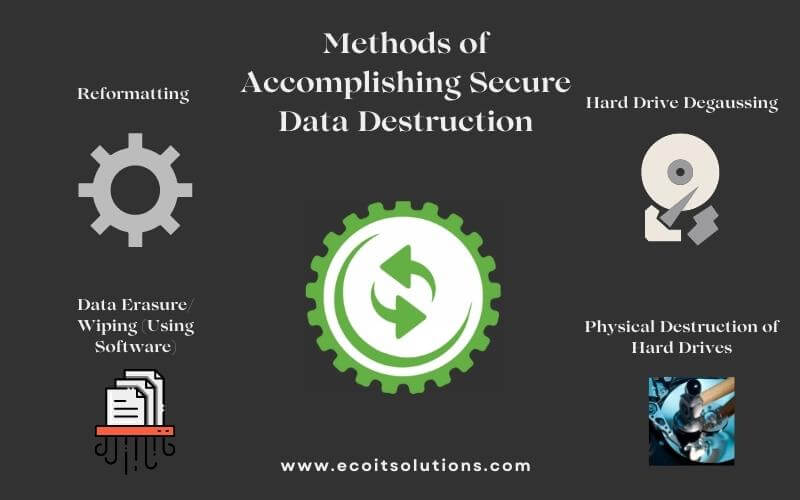Understanding the Role of Data Destruction in Strengthening Cyber Security Defenses
Understanding the Role of Data Destruction in Strengthening Cyber Security Defenses
Blog Article
Discovering the Relevance of Data Destruction in the Context of Computer Safety Providers and Protecting Confidential Information
In an era where information violations are progressively usual, the importance of effective information devastation can not be overemphasized. What approaches can organizations implement to enhance their data devastation procedures?
Recognizing Information Destruction
Data devastation is a vital element of computer system safety and security that involves the long-term removal of data from storage gadgets to prevent unauthorized accessibility and prospective information violations. In an increasingly electronic landscape, organizations face enhanced risks connected with delicate information being incorrectly accessed or manipulated. Effective data devastation safeguards against these risks, making sure that confidential dataâEUR" such as customer details, copyright, and financial recordsâEUR" can not be recuperated after disposal.
Understanding the relevance of data destruction extends beyond simple conformity with governing and legal structures; it is necessary for keeping organizational integrity and count on. When data is incorrectly taken care of or inadequately damaged, the repercussions can be extreme, including monetary loss, reputational damages, and lawful obligations.

Techniques of Information Removal

One prevalent technique is data cleaning, which entails overwriting existing information with arbitrary patterns numerous times. This strategy makes the initial information irretrievable, making it a prominent option for companies seeking to shield confidential info.
Another technique is degaussing, which makes use of an effective magnetic field to disrupt the magnetic domain names on storage devices, efficiently eliminating the data. This approach is specifically reliable for magnetic media yet is not suitable to solid-state drives.
Physical destruction is an additional durable method, squashing or entailing the shredding of storage space devices. This technique assurances that information recuperation is basically impossible, making it suitable for very sensitive information.
Finally, encryption can work as a complementary method to data elimination. By encrypting data prior to removal, companies can add an additional layer of protection, guaranteeing that also if residues are recovered, they stay unattainable without the decryption trick. Each method should be chosen based upon the level of data sensitivity and the specific protection demands of the organization.
Legal Conformity and Data Protection
Organizations must browse a complex landscape of legal needs associated to data protection, especially after applying approaches of data removal. Numerous policies, such as the General Information Protection Policy (GDPR) and the Wellness Insurance Coverage Portability and Liability Act (HIPAA), enforce stringent standards on just how companies must dispose and take care of of sensitive information. Failure to abide by these regulations can bring about considerable legal consequences, consisting of considerable penalties and reputational damage.
Data devastation procedures need to be carefully recorded to demonstrate compliance with applicable regulations and criteria. This paperwork not just works as proof of adherence to legal responsibilities but also shows a dedication to safeguarding sensitive information. Organizations should likewise establish clear policies concerning information retention and damage timelines, making sure that data is not held longer than required.

In addition, normal audits and evaluations of data damage practices are necessary to preserve conformity and adapt to progressing lawful frameworks (data destruction). By proactively addressing lawful demands, organizations can reduce risks related to data breaches and show their dedication to information security. Ultimately, focusing on legal conformity in data damage processes is not simply a regulatory responsibility, however a basic element of a durable information security technique
Influence On Organization Credibility
The online reputation of a company can be dramatically impacted by its approach to data destruction and management. In today's electronic landscape, where information violations can take place at any kind of minute, the failure to properly get rid of sensitive details can cause severe consequences. Organizations that inadequately handle information damage risk subjecting private client details, which not just violates privacy legislations however additionally erodes count on among customers and stakeholders.
A damaged track record can lead to lowered client commitment, as clients become hesitant to engage with a company that has demonstrated carelessness in safeguarding their information. Adverse publicity surrounding an information breach can have a lasting result, as possible consumers may be deterred by the perceived lack of safety and security. This can bring about a direct decline go to this web-site in revenue and market share.
Moreover, services that prioritize data destruction as component of their security strategy can boost their online reputation by showcasing their commitment to securing sensitive information. By taking on stringent data management methods, organizations can not only reduce dangers however likewise position themselves as reliable entities in their particular industries, thereby reinforcing their overall brand picture.

Ideal Practices for Secure Disposal
Executing finest methods for safe and secure disposal of data is necessary for reducing threats connected with data violations and ensuring conformity with personal privacy regulations. Organizations ought to adopt an extensive information disposal policy that describes treatments for both electronic and physical information damage.
For physical information storage space devices, such as hard disks, shredding or degaussing is advised to stop data healing. Additionally, companies need to preserve a chain of guardianship documents throughout the disposal process, making certain visit our website accountability and traceability of disposed products.
For electronic data, using software that sticks to sector standards for information wiping is crucial. This software program must overwrite existing information numerous times, making recovery practically difficult. It is additionally essential to verify the efficiency of the data damage procedure with audits or third-party assessments.
Training employees on protected disposal methods includes one more layer of protection, as human error can usually cause information exposure. Routinely upgrading and evaluating disposal plans guarantees positioning with developing regulations and technical developments. By implementing these ideal techniques, companies can considerably reduce the threat of unauthorized data access and enhance their total data security approach.
Conclusion
To conclude, information devastation is an essential element of computer system safety and security solutions that guarantees the defense of secret information from unauthorized access. Implementing reliable approaches of data obliteration, sticking to legal compliance, and recognizing the effect on service credibility are necessary parts of a thorough information security strategy. By taking on best techniques for secure disposal, organizations can foster trust fund with customers and secure delicate information, inevitably contributing to see a more secure electronic landscape.
In an age where data breaches are significantly typical, the value of reliable data destruction can not be overemphasized.Information damage is a crucial component of computer system safety and security that entails the irreversible removal of data from storage tools to prevent unauthorized accessibility and potential information breaches. Organizations must additionally develop clear policies concerning data retention and destruction timelines, guaranteeing that information is not held longer than needed.
By proactively dealing with lawful needs, companies can reduce risks linked with data violations and show their commitment to data safety and security (data destruction). Eventually, focusing on lawful conformity in information devastation processes is not simply a regulatory obligation, however an essential aspect of a durable information security approach
Report this page